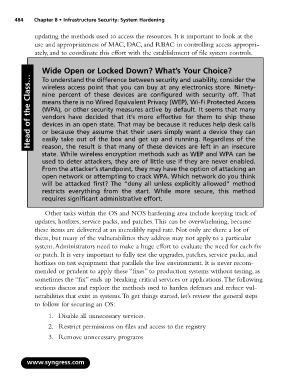Page 500 - StudyBook.pdf
P. 500
484 Chapter 8 • Infrastructure Security: System Hardening
updating the methods used to access the resources. It is important to look at the
use and appropriateness of MAC, DAC, and RBAC in controlling access appropri-
ately, and to coordinate this effort with the establishment of file system controls.
Wide Open or Locked Down? What’s Your Choice?
Head of the Class… nine percent of these devices are configured with security off. That
To understand the difference between security and usability, consider the
wireless access point that you can buy at any electronics store. Ninety-
means there is no Wired Equivalent Privacy (WEP), Wi-Fi Protected Access
(WPA), or other security measures active by default. It seems that many
vendors have decided that it’s more effective for them to ship these
devices in an open state. That may be because it reduces help desk calls
or because they assume that their users simply want a device they can
easily take out of the box and get up and running. Regardless of the
reason, the result is that many of these devices are left in an insecure
state. While wireless encryption methods such as WEP and WPA can be
used to deter attackers, they are of little use if they are never enabled.
From the attacker’s standpoint, they may have the option of attacking an
open network or attempting to crack WPA. Which network do you think
will be attacked first? The “deny all unless explicitly allowed” method
restricts everything from the start. While more secure, this method
requires significant administrative effort.
Other tasks within the OS and NOS hardening area include keeping track of
updates, hotfixes, service packs, and patches.This can be overwhelming, because
these items are delivered at an incredibly rapid rate. Not only are there a lot of
them, but many of the vulnerabilities they address may not apply to a particular
system.Administrators need to make a huge effort to evaluate the need for each fix
or patch. It is very important to fully test the upgrades, patches, service packs, and
hotfixes on test equipment that parallels the live environment. It is never recom-
mended or prudent to apply these “fixes” to production systems without testing, as
sometimes the “fix” ends up breaking critical services or applications.The following
sections discuss and explore the methods used to harden defenses and reduce vul-
nerabilities that exist in systems.To get things started, let’s review the general steps
to follow for securing an OS:
1. Disable all unnecessary services.
2. Restrict permissions on files and access to the registry
3. Remove unnecessary programs
www.syngress.com

